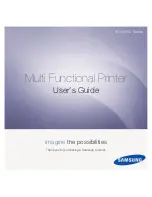
9-21
Appendix > Glossary
DHCP (IPv6)
DHCP (IPv6) is the next-generation of the Internet's Dynamic Host Configuration Protocol and supports IPv6. It extends
the BOOTP startup protocol that defines the protocols used for transferring configuration information to hosts on the
network. DHCP (IPv6) permits the DHCP server to use its expanded functionality to send configuration parameters to an
IPv6 node. Because the network addresses that can be used are allocated automatically, the IPv6 node management
workload is reduced in systems where the administrator has to exercise close control over IP address allocation.
dpi (dots per inch)
A unit for resolution, representing the number of dots printed per inch (25.4 mm).
EcoPrint Mode
A printing mode that helps save toner. Copies made in this mode are thus lighter than normal.
Emulation
The function to interpret and execute other printers' page description languages. The machine emulates operation of
PCL6, KPDL3 (PostScript 3 compatible).
Enhanced WSD
Proprietary web services.
FTP (File Transfer Protocol)
A protocol to transfer files on the TCP/IP network, whether the Internet or an intranet. Along with HTTP and SMTP/POP,
FTP is now frequently used on the Internet.
Grayscale
A computer color expression. Displayed images of this sort are typically composed of shades of gray, varying from black
at the weakest intensity to white at the strongest, without any other colors. Gray levels are displayed in numerical levels:
that is, white and black only for 1 bit; 256 gray levels (including white and black) for 8 bits; and 65,536 gray levels for 16
bits.
IP Address
An Internet protocol address is a unique number that represents a specific computer or related device on the network.
The format of an IP address is four sets of numbers separated by dots, e.g. 192.168.110.171. Each number should be
between 0 and 255.
IPP
IPP (Internet Printing Protocol) is a standard that uses TCP/IP networks such as the Internet to enable print jobs to be
sent between remote computers and printers. IPP is an extension of the HTTP protocol used to view websites and
enables printing to be carried out via routers on printers in remote locations. It also supports the HTTP authentication
mechanisms along with SSL server and client authentication as well as encryption.
Job Box
The Job Box function stores print data on the printer and allows users to print single or multiple copies of the stored data
later using the printer's operation panel.
KPDL (Kyocera Page Description Language)
Kyocera's PostScript page description language compatible with Adobe PostScript Level 3.











































